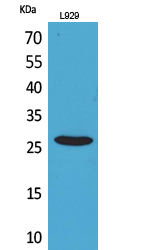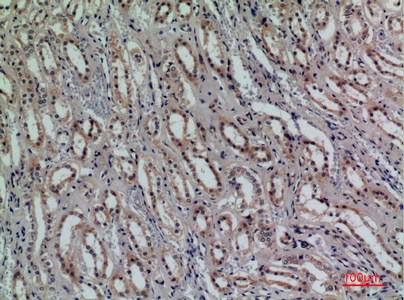

| WB | 咨询技术 | Human,Mouse,Rat |
| IF | 咨询技术 | Human,Mouse,Rat |
| IHC | 1/50-1/100 | Human,Mouse,Rat |
| ICC | 技术咨询 | Human,Mouse,Rat |
| FCM | 咨询技术 | Human,Mouse,Rat |
| Elisa | 1/10000 | Human,Mouse,Rat |
| Aliases | KLRC1; NKG2A; NKG2-A/NKG2-B type II integral membrane protein; CD159 antigen-like family member A; NK cell receptor A; NKG2-A/B-activating NK receptor; CD159a; KLRC2; NKG2C; NKG2-C type II integral membrane protein; CD159 antigen-like family member C; NK cell receptor C; NKG2-C-activating NK receptor; CD159c; KLRC3; NKG2E; NKG2-E type II integral membrane protein; NK cell receptor E; NKG2-E-activating NK receptor |
| Entrez GeneID | 3821 |
| WB Predicted band size | Calculated MW: 26 kDa; Observed MW: 26 kDa |
| Host/Isotype | Rabbit IgG |
| Antibody Type | Primary antibody |
| Storage | Store at 4°C short term. Aliquot and store at -20°C long term. Avoid freeze/thaw cycles. |
| Species Reactivity | Human |
| Immunogen | The antiserum was produced against synthesized peptide derived from the Internal region of human KLRC1/2/3. AA range:101-150 |
| Formulation | Purified antibody in PBS with 0.05% sodium azide,0.5%BSA and 50% glycerol. |
+ +
以下是关于CD159a/c(NKG2A/C)抗体的参考文献,按需求整理如下:
---
1. **文献名称**: *Anti-NKG2A mAb Is a Checkpoint Inhibitor that Promotes Anti-Tumor Immunity by Unleashing Both T and NK Cells*
**作者**: André, P. 等
**摘要**: 该研究证明抗NKG2A单克隆抗体(如Monalizumab)能通过阻断NKG2A-HLA-E信号通路,解除T细胞和NK细胞的抑制,增强抗肿瘤免疫反应,并在临床前模型中与PD-1抑制剂协同增效。
2. **文献名称**: *NKG2A Blockade Potentiates CD8 T Cell Immunity Induced by Cancer Vaccines*
**作者**: van Hall, T. 等
**摘要**: 研究发现,阻断NKG2A可增强癌症疫苗诱导的CD8+ T细胞应答,通过解除NK和T细胞的共同抑制信号,提高对肿瘤抗原的识别能力,为联合免疫治疗提供新策略。
3. **文献名称**: *Adaptive NK Cells in Human Cytomegalovirus Infection: Role of NKG2C and Antibody-Dependent Activation*
**作者**: Zhang, T. 等
**摘要**: 探讨NKG2C+ NK细胞在CMV感染中的扩增机制,揭示抗体依赖的细胞毒性(ADCC)通过结合CD16和NKG2C信号通路,驱动适应性NK细胞应答,影响抗病毒免疫。
4. **文献名称**: *CD94/NKG2 Receptor Biology: From Structure to Functional Adaptation*
**作者**: Höglund, P. 等
**摘要**: 综述CD94/NKG2家族(包括NKG2A/C)的结构与功能,强调其在NK细胞免疫监视中的双重作用(抑制/激活),并讨论靶向抗体在感染和癌症中的治疗潜力。
---
以上文献涵盖基础机制、治疗应用及疾病关联研究,均涉及CD159a/c抗体在免疫调控中的关键作用。
CD159a (NKG2A) and CD159c (NKG2C) are cell surface glycoproteins belonging to the C-type lectin-like NKG2 family, primarily expressed on natural killer (NK) cells and subsets of T lymphocytes. These receptors form heterodimers with CD94. creating inhibitory (NKG2A/CD94) or activating (NKG2C/CD94) complexes that interact with HLA-E molecules presenting peptide antigens. NKG2A/CD94 delivers inhibitory signals via immunoreceptor tyrosine-based inhibition motifs (ITIMs), dampening NK cell cytotoxicity upon HLA-E recognition, thereby maintaining self-tolerance. In contrast, NKG2C/CD94 associates with adaptor proteins (e.g., DAP12) containing immunoreceptor tyrosine-based activation motifs (ITAMs), promoting effector functions in response to stress or infection.
Antibodies targeting CD159a/c are critical tools for studying NK cell biology, immune regulation, and disease associations. Anti-CD159a antibodies help identify NK cell subsets with distinct functional profiles, while anti-CD159c antibodies are used to explore activating responses in viral infections (e.g., cytomegalovirus) or cancer. Clinically, CD159a/c expression patterns correlate with outcomes in transplantation, autoimmune disorders, and immunotherapy. Blocking NKG2A (e.g., monalizumab) is under investigation to enhance anti-tumor immunity by disinhibiting NK and CD8+ T cells. These antibodies also aid in diagnosing immune dysregulation and optimizing adoptive cell therapies.
×